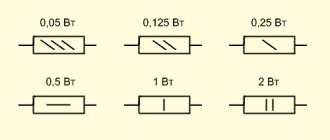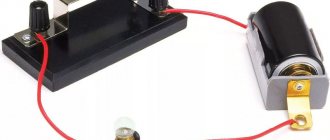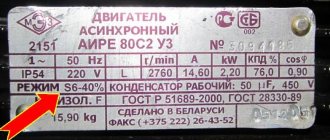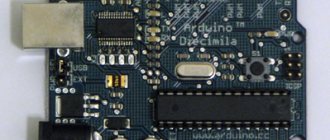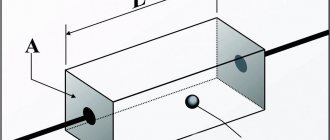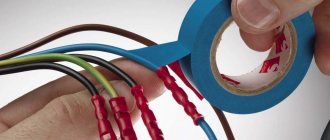If you are reading this article, it means that you are either faced with a choice - which arc flash protection device (AFDP) to buy, or you have read the previous post and are driven by curiosity.
Important announcements before we start testing:
- The devices are “smart” and have microcontrollers inside them. This means that the quality of their work depends on the firmware inside the microcontroller. Therefore, the relevance of the text is limited in time - devices are being further developed, while remaining externally the same! I really hope that manufacturers will indicate the firmware version on the case, and the changes made on their website.
- At my request, the devices were sent by the manufacturers, without any conditions (here it is, the super power of a blogger!), and for this I want to say a huge thank you to them. But such manufacturers as ABB, Siemens, schneider electric, Eaton simply ignored my letters, so they are not included in the tests. (aborouhin, I tried)
- I also recommend that you read the previous post about what an AFPD is and how they work.
- Additional information on the tests is provided in the video, but the main results are given here.
For video lovers, I recorded a video version
Devices tested
The current situation is that arc flash protection devices are being developed and produced in our country. And I managed to get a copy of each device. And one more device that is sold on the Russian market, but which was developed jointly with Chinese engineers and is produced in China. Having developers in Russia is a huge plus, which allows you to establish direct contact and, if necessary, productively solve specific problems, which is almost impossible if the developers are located in another country and are reliably fenced off from contacts by several layers of management.
- IEK UZDP63-1
Device sold under the IEK brand. This is of course an open secret, but devices for IEK are developed and manufactured by Ecolight. Development and production are located in Russia. (On the hub there is a representative of ecolight YUshakov) - Source UZDP-S1-63A-1-2
The device is developed and manufactured by Ecolight. Development and production are located in Russia. - UZM-50MD
The device is produced by the company Meander, known for various electrical products. Development and production are located in Russia. This model is being discontinued, and another model has been announced for release in 2022. - UZO-ELTA-2D
The device was developed and produced by Elektroavtomat JSC in the small town of Alatyr in Chuvashia. Development and production are located in Russia. - EKF AFDD-2-25C-pro
The device is sold by EKF, but the device was developed jointly with Chinese engineers and is manufactured in China.
Let's start with a comparison of the declared functions. Some devices are a combination of several components, for example, not only arc flash protection, but also short circuit protection, thanks to a built-in circuit breaker.
| Source UZDP-S1-63A-1-2 | IEK UZDP63-1 | UZM-50MD | UZO-ELTA-2D | EKF AFDD-2-25C-pro | |
| Arc flash protection | + | + | + | + | + |
| Overvoltage protection | + | + | + | + | — |
| Undervoltage protection | — | — | + | — | — |
| Surge protection | + | + | + | + | — |
| Short circuit protection | — | — | — | + | + |
| Leakage current protection | — | — | — | + | — |
It is clear that UZO-ELTA-2D is the leader. It protects against almost everything: from voltage exceeding normal limits, from short circuit currents, and from leakage currents. But the lack of overvoltage protection in the EKF AFDD-2-25C-pro raises questions, since this function is almost “free” for the developer.
Why is arc protection installed?
There are many factors that can lead to arcing. And the largest number of them are in the residential sector. The source of danger may be:
- damaged line cable;
- cut of cable lines inside the building;
- pinching with penetration of cable insulation by doors;
- poor-quality installation of electrical components; you can often find sockets falling out;
- damage to the cable line by rodents;
- cable penetration in the wall when installing finishing elements.
Installation of Eaton AFDD+ circuit breakers guarantees safety for residents and workers if there are dangerous risks on the territory of any organization.
Test one - false positive.
Methodology - we walk around the workshop and collect all the interesting electrical appliances.
We connect them to the circuit with the AFDD five times with a pause of 2 seconds between switching on (or a little more). We enter the data into the table: (+) - the load works without problems. (-) - false triggering of the AFDD is single, not repeated (X) - testing is impossible, the load is too powerful and the circuit breaker is triggered by overload, by current (!) - stable false triggering
| Load | Source UZDP-S1-63A-1-2 | IEK UZDP63-1 | Meander UZM-50MD | UZO-ELTA-2D B6 30mA | EKF AFDD-2-25C-pro |
| Construction hair dryer 2000W | + | + | + | + | + |
| Large grinder P=2kW | + | + | + | X | + |
| Small grinder 800W | + | + | + | + | + |
| Semi-automatic welder overman 180 | + | + | + | X | + |
| Inverter welder ergus A200 | + | + | + | +/X | + |
| Vacuum cleaner electrolux airmax 2000 W | + | + | + | + | + |
| Moron with a kettle 2 kW | + | + | ! | + | + |
| Metal trimmer dewalt d28720 2300 W | + | + | + | X | + |
| Drill with short-circuit rotor 450W | + | + | + | ! | + |
| UFO-B lamp 400W | ! | ! | + | ! | + |
| Drilling machine with asynchronous motor 250W | + | + | + | ! | + |
| Smooth activation of the key switch, load 1 kW | ! | ! | ! | + | + |
| Soviet electric shaver Kharkov 6m and Kyiv-5 | + | + | — | ! | + |
| 1 kW spotlight through a thyristor regulator from a vacuum cleaner (turn it on - dim it back and forth 2 times and turn it off) | ! | ! | ! | ! | + |
| Spark generator 65W | + | + | + | ! | + |
| LDS with inductive ballast 72W | + | + | + | not tested | not tested |
| Homemade carbon electrode welding machine, 350 W | + | + | + | + | + |
| Electronic transformer for halogen lamps 200 W | + | + | + | + | + |
A separate test is “a moron with a teapot”, with me in the role of the moron. We quickly turn the kettle switch on and off, as if a child were playing with a light switch. The sparking in the switch is minimal, thanks to the spring, but it generates current surges and voltage sags. Surprisingly, the UZM-50MD was the only one that gave a false alarm under such conditions.
A spark generator is a device (not mass-produced, fortunately) that produces discharges up to 40 mm long, with the help of which children are shown various physical experiments. Inside is a good switching power supply 230V -> 12V 65 W, loaded through a generator onto two ignition coils, which produce a spark discharge. During operation, the device generates a lot of noise into the network, which is noticeable on the oscilloscope screen.
Smooth activation of a key switch is the most unreproducible test, but it is more likely to determine whether a child with playful hands can cause a false operation, or whether there is excessive sensitivity in detecting an arc fault. All switches are designed so that the contacts turn on and off sharply, minimizing arcing. But if the contacts are oxidized, or dust gets inside the switch, then the switch can spark quite strongly.
What the test showed:
- The complete absence of false alarms, especially on a load like a thyristor regulator without filters or a UFO-B lamp, is rather an indicator of reduced sensitivity, which was confirmed in the response time test.
- Power tools with motors and welding machines usually do not cause problems. It was surprising that the ELTA device gave a false response to start the asynchronous motor of the drilling machine, but otherwise the response to a power tool is more likely an indicator of abnormal operation of the power tool itself and possibly a serious defect.
- Soviet electric shavers - hellish devices, having a current consumption less than the minimum arc detection current (2.5A) created enough noise in the network to trigger the AFDD when they were turned on, which once again confirms my words from the previous post - if you have old devices, then for To solve problems with false positives, you will need to use a surge protector.
I’ll add it to the topic of switches, since I got a visual photo. This is what a switch looks like if it has accumulated a lot of dust, causing it to crackle and work unstably, which requires replacement.
The AFPD will operate for such a defect, since a sequential arc breakdown occurs. If measures are not taken in time, strong heating will occur, followed by melting of the case. That is why everything that surrounds the electrical wiring should not support combustion:
Insert/edit link
The use of AFDCs is becoming mandatory for many types of objects in Russia
Alexey Vasiliev, individual entrepreneur
Among the most common causes of fires is a violation of electrical contact with the occurrence of an arc breakdown (called sparking in everyday life). Only an arc flash protection device (AFPD) can prevent a fire due to this phenomenon by promptly de-energizing the power supply line. From September 1, 2021 in Russia, the use of AFDCs becomes mandatory at certain types of facilities. The article describes the principle of operation of such devices, the features of their installation, as well as regulations requiring the mandatory use of AFDCs at certain facilities.
Among the most common causes of fires is a violation of electrical contact with the occurrence of an arc breakdown (called sparking in everyday life). Only an arc flash protection device (AFPD) can prevent a fire due to this phenomenon by promptly de-energizing the power supply line. From September 1, 2021 in Russia, the use of AFDCs becomes mandatory at certain types of facilities. The article describes the principle of operation of such devices, the features of their installation, as well as regulations requiring the mandatory use of AFDCs at certain facilities.
In addition to circuit breakers and residual current devices, another type of device that increases the level of safety is increasingly found in electrical panels. We are talking about arc flash protection devices (AFPD), which in some sources are also called spark protection devices (USPD).
The fact is that often the cause of a fire is a violation of electrical contact (for example, damage to a wire core) with the occurrence of an arc breakdown, which at the everyday level is defined as “sparking.” The idea of an AFDD, as they say, was “in the air,” but only in the 2000s, thanks to advances in the development of microprocessor technology, it was possible to create reliably triggered AFDDs that were compact enough to be placed in an electrical panel on a standard DIN rail ( Fig. 1).
Studies in the USA have shown that the share of fires due to arc flashover is 80% or higher in the total number of fires associated with electrical equipment [1]. In Russia, the situation is approximately the same - up to 80% of “electrical” fires occur due to arc breakdown that occurs in places where normal contact between elements of electrical networks and electrical installations is disrupted [2, 3].
Rice. 1. Modern AFDDs are compact devices mounted on a DIN rail
It should be noted that, although almost all wiring in rooms with constant occupancy requires AFDC protection, such protection of hidden electrical wiring is especially important, for example, for lines supplying power to ceiling lamps. The condition of such wiring is difficult to monitor visually. And, in the event of a fire in a hidden part of the wiring, it is not so easy to extinguish it with improvised means.
Positive experience in the operation of AFDCs, which showed their benefits, as well as a series of large fires due to sparking, led to the fact that the use of AFDCs at sites where safety is critical is mandatory or recommended by national standards in the UK, Slovakia, Germany, Austria, Canada, Australia and New Zealand. In general, IEC 60364-42:2014 Low-voltage electrical installation - Part 4-42: Protection for safety - Protection against thermal effects is in force worldwide, which recommends the use of SPDs. Moreover, where the use of an ultrasonic protection device is not mandatory, but only recommended, economic levers operate - fire insurance for premises in the absence of protection against sparking is carried out at increased prices.
Now, in our country, the need to introduce ultrasonic control devices has been officially recognized at the state level.
Arc breakdown - characteristic features, causes of occurrence
Experts identify the following typical cases of arc breakdown (sparking):
— damage to the insulation of a current-carrying cable by fastening elements without a complete short circuit;
— cable break due to an unacceptably small bending angle;
— damage to the cable in places of constant pressure or regular bending (electrical appliances moving in space)
— damage or aging of insulation caused by exposure to climatic factors, ultraviolet radiation, chemicals, etc.;
- damage caused by rodents;
— loss of contacts due to oxidation of wires, weakening of pressure, etc. factors;
— malfunctions in electrical equipment or its improper operation.
There are two types of arc breakdown: parallel arc breakdown, which occurs as a result of insulation failure between the phase and neutral conductors or between the phase and grounding conductors, in this case the arc current runs parallel to the load, hence the name “parallel” breakdown (Fig. 2). In a sequential arc breakdown, the arc current that occurs at the point of contact failure or conductor defect also flows through the load.
Rice. 2. Types of arc breakdown: 1 - Serial arc breakdown, 2 - parallel phase-zero arc breakdown, 3 - parallel phase-ground arc breakdown
As for damage to the wire core, it is not at all necessary that it immediately results in a break.
Short circuit, burnt cable, on dark color background
Rice. 3. The wire may catch fire as a result of sparking that occurs at the site of damage to the core, accompanied by a decrease in its cross-section
It is enough that the cross-section of the core at the site of damage is significantly reduced. The current continues to flow, but the core at the point of damage heats up, the remaining jumper melts, and a spark occurs between the two pieces of the core (Fig. 3). According to the Ministry of Emergency Situations, approximately 23% of fires are associated with electrical wiring (Fig. 4).
Rice. 4. Distribution of causes of fires
An arc breakdown can be either an independent emergency mode in the electrical network or accompany other dangerous modes. Often, sparking is caused by degradation of the insulation of current-carrying elements as a result of heat generation in places of defects in contact transitions of electrical circuits (high transition resistance mode - BTS).
In general, a sequential arc breakdown can be considered a more dangerous and fire-hazardous phenomenon, since this type of breakdown cannot be recognized by either circuit breakers or residual current devices. Therefore, only an AFPD can save you from a fire in the event of a sequential arc breakdown - see table. 1.
Table 1. Response of electrical circuit protection devices to different types of arc fault.
| Protection device | Type of arc breakdown (sparking) | ||
| Consistent | Parallel phase-neutral | Parallel phase-ground | |
| Circuit breaker | Doesn't define at all | May trip too late (with limited short-circuit current) | May trip too late (with limited short-circuit current) |
| Residual current device (residual current switch) | Doesn't define at all | Doesn't define at all | May not feel (if sparking is impulsive) |
| UZDP (UZIS) | Disables the circuit | Disables the circuit | Disables the circuit |
Operating principle of the AFDP
When an arc breakdown occurs in the power line, its parameters change significantly - voltage, current, and high-frequency harmonics appear. The UZDP monitors the condition of the line and, based on the data received, makes a decision to de-energize it. Specific algorithms vary from manufacturer to manufacturer and are the “know-how” of these companies.
However, there is one parameter that almost all SPDs evaluate due to the principle of operation - the spectrum of the current in the load. If you take a radio, turn it on in the AM range and bring it to the place of sparking (the experience is purely imaginary, do not repeat it in practice - if sparking occurs, immediately turn off the line!), You will hear powerful noises and crackles. The main task of the AFDD is to detect such signals on the line and distinguish them, say, from interference caused by switching. For this purpose, high-quality AFDDs, for example, UDDP-S1 Istok from, use digital signal processing.
A big problem for AFPDs is the presence of load types, for example, commutator electric motors, which produce a spectrum similar to sparking. All kinds of switching power supplies, including those used in lighting devices, also pose a certain problem. This problem is being solved experimentally - the types of load at which false triggering occurs are determined, and the operating algorithm of the microprocessor built into the AFDD is being finalized. Therefore, AFDDs developed by companies that have been working on this issue for a long time have certain advantages. For example, the Russian one has been researching in the field of AFDCs for 15 years, which led to the creation of large-scale production of AFDDs. The operator of the project is JSC Ecotech, a joint venture between Ecolight and one of the enterprises included in the Rostec State Corporation. Data on the UZDPs available for free sale in our country are given in Table. 2.
Table 2. Main characteristics of AFDCs available for free sale in Russia as of July 2022 (price data are indicative, taken from open sources)
| Manufacturer , country | Name _ | Rated current, A | Size on DIN rail (modules) | Trigger cause indication | Testing (manual/automatic).) | Retail price , rub. | Additional Features/Note |
| Russian manufacturers | |||||||
| Ecotech (Source) Russia | UZDP-S1 | 16, 25, 32, 40, 63 | 2 | Continuous | Auto. + manual (external device) | 6 000 | 1. Overvoltage shutdown with a threshold of 270 V 2. Availability of an independent means of monitoring the area of operation and performance included in the kit 3. Non-switchable indication of the cause of operation |
| Ecolight Russia | UZIS-S1 | 16, 25, 32, 40, 63 | 2 | Continuous | Auto. + manual (external device) | 5 200 | 1. Overvoltage shutdown with adjustable value 260, 270, 280, 290 V 2. Availability of an independent means of monitoring the area of operation and performance included in the kit 3. Non-switchable indication of the cause of operation |
| IEK Russia | UZDP63-1 | 16, 25, 32, 40, 63 | 2 | Continuous | Auto. + manual (external device) | 4 587 | 1. Overvoltage shutdown with a threshold of 280 V 2. Availability of an independent means of monitoring the area of operation and performance included in the kit 3. Non-switchable indication of the cause of operation |
| Meander Russia | UZM-50MD | 63 | 2 | Continuous | No | 2 660 | 1. Voltage control relay - shutdown when the network voltage is more than 270 V / less than 155 V Does not comply with GOST IEC 62606-2016 (clauses 8.2.2 and 8.6.2.2): – there is no free release mechanism, there is automatic re-closing; – does not meet the standard for the minimum detectable sparking current – 5 A instead of 2.5 A; |
| EKF Russia | AFDP PROxima | 16, 20, 25, 32 | 2 | After restarting | Auto. + manual | 6 335 | 1. Integrated AB, type C 2. There is no indication of the activation of the built-in AV 3. The actual manufacturer is a company from China |
| Foreign manufacturers | |||||||
| Eaton USA | AFDD | 10, 13, 15, 16, 20, 25, 32, 40 | 3 | After restarting | Auto. + manual | 10 657 | 1. Integrated AV, type B, C 2. Overvoltage shutdown with a threshold of 270 V 3. Integrated RCD, current difference 0.01A, 0.03A 4. There are models with increased shutdown time (selectivity) |
| Schneider Electric France | iDPN N ARC Acti9 | 6, 10, 16, 20, 25 | 2 | Mechanical | Auto. + manual | 9 198 | 1. Integrated AV, type B, C 2. Shutdown when voltage exceeds 400V, shutdown time 200ms |
| ABB Switzerland | S-ARC1 | 6, 10, 13, 16, 20, 25, 32, 40 | 2 | After restarting | Auto. + manual | 10 790 | 1. Integrated AB, type B, C 2. Overvoltage shutdown with a threshold of 275 V 3. Integrated RCD, current difference 0.01A, 0.03A (with the letter D in the name), then the rated current is up to 20 A Does not comply with GOST IEC 62606-2016 (clause 8.17): – if the autotest result is negative, the device flashes red-green, but does not turn off, and must be checked with a manual test. |
| DS-ARC1 | 6, 10, 13, 16, 20 | 3 | |||||
Installation Features
The SPD can be implemented in one of the following options:
— a separate device, including an arc fault detection unit and a tripping mechanism (release), it can only be used in conjunction with an external overcurrent protection device;
— a combined device, which is an arc fault detection unit and an overcurrent protection device (circuit breaker, with or without a residual current switch) in one housing;
— a composite device consisting of an arc fault detection unit without a trip device, which is mechanically connected to an overcurrent protective device (also with or without a residual current switch).
Depending on this, one or another circuit for switching on the AFDC is selected. The use of AFDCs is regulated in detail by SP 256.1325800.2016 “Electrical installations of residential and public buildings. Design and installation rules", Appendix B.
It should be noted that the AFDD operates effectively within a certain range specified in the accompanying instruction manual. Therefore, the AFDD is installed on each group line, but for small premises it is allowed to install the AFDD only on the input line.
The possibility of protecting a specific consumer, as well as the actual performance of the AFDC, is determined by briefly installing a special spark simulator in the socket.
In some cases, the use of an AFDC is unacceptable. It is prohibited to install them in group power supply networks of fire protection systems, as well as to power medical electrical installations that support the vital functions of patients through the AFDC.
Legal basis for the application of UZDP
GOST R 50571.4.42-2017, which is an adaptation of the already mentioned IEC 60364-4-42:2014, recommends the use of AFDD as a special protective measure to prevent fires from arc breakdown in electrical circuits of end consumers (clause 421.7):
- in premises with constant presence of people for a long time;
- in premises with the presence of fire hazardous materials being processed or stored, that is, premises of class BE2. (for example, warehouses, stores selling wood materials, stores selling flammable materials);
- in premises using flammable building materials, that is, premises of class CA2 (for example, wooden buildings);
- in premises using structures that facilitate the spread of fire, that is, premises of class CB2;
- in premises where irreplaceable property is at risk.
However, the application of this standard is voluntary.
Damaged electrical junction box became cause of electrical short circuit and caused the electrical wiring to ignition of fire.
Rice. 5. Sparking as a result of broken electrical contact cannot be detected by a conventional circuit breaker, however, it can lead to a fire
Emergency operation of electrical networks and equipment is the most common cause of fires in buildings and premises (Fig. 5). The share of such fires in the total number of fires has only been growing in recent years. For example, in 2022, 63% of fires in educational buildings, 49% of fires in health care and social service buildings, and 34% in residential buildings occurred for this reason. Therefore, it was decided to make the use of AFDC mandatory for the listed types of objects.
From September 1, 2022, Russia will introduce the mandatory use of AFDC devices (USIS) in electrical installations of newly constructed and reconstructed buildings:
— preschool educational organizations, specialized homes for the elderly and disabled (non-residential), hospitals, dormitory buildings of educational organizations with the presence of a boarding school and children's organizations;
— multi-apartment residential buildings with a height of more than 75 meters and multi-apartment residential buildings of any number of floors, which use electrical wiring made of aluminum alloys;
— general educational organizations.
The legal basis for this is SP 256.1325800.2016 “Electrical installations of residential and public buildings. Design and Installation Rules" with amendments Nos. 1,2,3 and 4. Clauses 10.13, 12.2, 15.41, 15.44 and Appendix "B" with the exception of the positions of Table B.1 with functional fire hazard classes F1.2, F1.4, F2.1, F2.2, F3.1 - F3.7, F4.2, F4.3, F5.2, sections B.4, B.5 are included in the List of national standards and codes of practice (parts of such standards and codes rules), as a result of which the application ensures mandatory compliance with the requirements of the Federal Law “Technical Regulations on the Safety of Buildings and Structures”, approved by Decree of the Government of the Russian Federation of May 28, 2021 No. 815. The entry into force of the specified technical regulations makes the use of AFDD mandatory for some types of objects .
conclusions
The introduction in Russia of the mandatory use of AFDCs at certain types of facilities should help reduce the number of fires associated with electricity. At the same time, new prospects are opening up for Russian manufacturers of AFDCs. Domestic companies can better take into account the specifics of our power supply networks and the most common types of electrical appliances in the country. We also note the more affordable prices of Russian manufacturers compared to foreign ones, as well as the possibility of prompt delivery of large quantities, which is especially important for mass use.
LITERATURE
Test two. Determination of sensitivity.
According to GOST, the minimum arc fault detection current is 2.5A.
For the test, I assembled a stand that had a series circuit consisting of a breaker (a metal electrode and a carbon electrode, which can be moved apart with a handle with a screw), rheostats for setting the current, and a control ammeter. There is only one load here, so these are super hothouse conditions for the AFDP. In this test, the response time was not measured, only the fact itself was checked - it works / does not work. The result is that all devices detect a sequential arc breakdown with a current of 2.5A, which is prescribed by GOST. But the ISTOK AFDD has a sensitivity much better than that prescribed by GOST, and a sequential arc breakdown with a current of 1A was detected.
Causes of arc breakdown
Arc breakdown can occur for many reasons, most often in domestic or working conditions it occurs under the influence of the following factors:
- There are crushed cables in the electrical system that have been damaged, say, due to mechanical pressure, a wire getting caught under a heavy object, etc.;
- Damage to insulation, both mechanical and due to natural wear and tear;
- Electricians categorically do not recommend twisting cables made of various materials, namely aluminum-copper. Contacts oxidize and can cause breakdown;
- Cables in warehouses or in production are often damaged by rodents;
- Poor contact or existing cable defects.
As you can see, any of these reasons can happen in almost any conditions, so the best protection is the competent installation of an EATON AFDD+ AFDD+!
Test three. Determination of response speed.
I installed a carbon and tungsten electrode into the breaker.
The current was set using rheostats, and as a result, a sequential arc breakdown with a current of 2.5A, 5A, 16A was simulated. Both the electrodes in the chopper and the screen of the oscilloscope connected to the current sensor were filmed. Then, from the video, by counting frames with a glow between the electrodes, the arc burning time was determined, which was interrupted by turning off the AFDP or extinguished on its own. The time values are listed on the plate (I did at least 10 ignitions). The measurement error is at least 2 frames (0.08 sec), as well as a difficult-to-determine error when a particle of the carbon electrode heats up and glows, but has not yet burned out and the arc has not ignited, so the error in determining the arc burning time tends to overestimate the time:
I thought for a long time about what parameter to come up with for a numerical assessment, but I decided to simply depict it visually. Blue bars - the arc extinguished by itself during a sequential arc breakdown. Green - the arc has gone out due to the AFPD being disconnected. The scale on the chart is 0-3 sec. If the column is higher, the burning time in seconds is written above it, and in some places there are some monstrous values of tens of seconds! The red dotted line is the time limit according to GOST. The number of columns is different, since I achieved the ignition of at least 10 arc breakdowns, and then had fun with the breaker until I got tired of it.
What the test showed: only the IEK UZDP63-1 device and Istok UZDP-S1-63A-1-2 work reliably, like a Kalashnikov assault rifle and clearly cut the arc in accordance with GOST. The UZM-50MD device is a clear outsider. It clearly lacks sensitivity and at a current of 2.5A the arc burned without shutting down for tens of seconds. At high currents, the device also took a long time to “figure out” before turning off. EKF and ELTA showed intermediate results.
Test four. Crosstalk.
The AFDD should not react to sparking devices prior to its entry.
But if there are long lines, sparking will cause voltage sags, which in turn will lead to current fluctuations in the load, which the SPD should already see. To prevent sparks from your neighbor from causing your AFDD to turn off, device developers are taking measures. For the test, I assembled a stand where long lines are simulated by series-connected resistors with a resistance of several ohms. Before the AFDD, an electric kettle with a breaker is turned on, and after the AFDD, the load is 1 kW. Thus, during a sequential arc breakdown in the kettle circuit, the voltage at the input to the AFDD dropped from 223V to 180V.
None of the AFDDs generated false alarms due to crosstalk during the test.
Test five. Grinder with a broken cord.
Just in time, my colleagues put me on the workbench to repair an angle grinder, which had broken wire strands near the body. When the cord was bent, the chain opened and the angle grinder stopped. If you get used to it, you can grab the angle grinder so that when you turn it on, it will jerk from acceleration, the contact will be broken, it will stop, and so on cyclically. Of course, I decided to try it on the AFDP, and here is the result:
- IEK UZDP63-1 - tripped
- Source UZDP-S1-63A-1-2 - did not work
- UZO-ELTA-2D - worked
- Meander UZM-50MD - worked
- EKF AFDD-2-25C-pro - did not work.
If I were the manufacturers, I would throw rotten tomatoes at such an irreproducible test, but it is closest to a “combat” situation with a broken cable and I was lucky that such a cable was at hand. The test is also notable for the fact that the ISTOK and IEK devices are similar in appearance, but performed differently in the test, so I emphasize once again that the characteristics of the device depend very much on the version of the software built into it. And they can work just from such a cable with broken wires or poor contact in the socket.
Different approaches and sparking simulator.
The devices are notable for the fact that they demonstrate a completely different approach to creation.
The IEK and Istok devices were actually created from scratch specifically to perform the arc flash protection function. For the UZM-50MD device, the arc detection function was added to the already completed and successful overvoltage/undervoltage protection relay UZM-50M. The device from ELTA is a slap on the independently existing circuit breakers that the company produces. If desired, the AFDC can be separated from the circuit breakers and they will continue to operate. The device from EKF was obtained by enlarging the AFDD housing to add a circuit breaker, and the circuit breaker is hidden inside the common housing. The set of devices from IEK/Istok includes a spark simulator, which allows you to kill several birds with one stone. Firstly, it allows you to check the performance of the AFDD. When the simulator is connected to the network, the AFDD should turn off. Secondly, the simulator allows you to determine that an arc fault at a specific socket/carrying device will be visible to the AFDD, and will not go unnoticed due to the inductance of a long line or an evil noise filter in a device nearby. Devices from other manufacturers do not have anything similar, and it will be difficult to check their performance. I really liked this concept, but was disappointed by the lack of a loop/hole or other fastening for the simulator, which prevents it from being attached to a keychain for electrical panels.
Technically, the simulator is a device in which a MOSFET switch is loaded onto a pair of resistors and briefly creates inrush currents of 2.5A (lower detection limit according to GOST). The spark simulator only works with IEK/Istok AFDD; devices from other manufacturers do not work with it (and are not required to). The oscillogram of the simulator is below:
▍ Which is better, IEK or Istok?
Although these are actually devices from the same manufacturer, there are slight differences in behavior, but within the limits permitted by GOST. So for the consumer there is no difference. The fact that identical devices are produced under two brands is a purely corporate story, when a young and ambitious company comes to a major player (IEK) and is ready to sell its product under someone else’s brand, for the sake of established sales channels, marketing and other goodies, but in the exchange will twist her arms in terms of price. Plus, a large company that produces a third-party product under its own brand usually meticulously checks the quality, because if something happens, all the bumps will fall on them. I don't see a significant difference for the consumer between these two devices, the only question is what is available where you usually purchase.
What is UZDP
AFDP - arc flash protection device - a specialized device designed to automatically warn and prevent fire from sparking/arc flash in electrical networks and electrical installations - the most common cause of “electrical” fires.
AFDC is the third stage in the development of power grid protection means after circuit breakers (AB) and residual current devices (RCD). The AFDD is installed in the electrical panel on a standard DIN rail. In the event of an arc breakdown in the protected section of the electrical network, the device disconnects this section from the supply network.
Next, we will consider in more detail why an AFPD is needed and how it prevents fires.
- Faulty electrical wiring and equipment is the most common cause of fires.
The most common cause of fires in buildings is the emergency operation of electrical networks and equipment, and the share of “electrical” fires in the total number of fires in Russia is only growing. For example, in 2020, 63% of fires in educational buildings, 49% of fires in health care and social service buildings, and 34% in residential buildings occurred for this reason. Such a high share is explained by the general increase in the power supply of residential and public buildings while the pace of reconstruction of electrical networks lags, untimely maintenance of electrical installations, and wear and tear of electrical equipment and wiring.
Emergency mode should be understood not only as a malfunction of electrical equipment, but also as a violation of the integrity of electrical networks and wiring, improper installation and installation of electrical equipment, overloading of electrical circuits, etc. The danger of “electrical” fires is that the fire sites are usually hidden or in inaccessible places, and the fire has time to flare up before the source of the fire is detected.
Nowadays, it is probably impossible to find a residential building, much less a public building, where circuit breakers are not installed to protect against short circuits and overloads in the network. Most buildings also have residual current devices (RCDs) installed that respond to current leakage, the main purpose of which is to protect people from electric shock in the event of an insulation failure.
So why is the number of “electrical” fires not decreasing if automatic circuit breakers and RCDs are installed almost everywhere, and millions more are installed every year?
- Arc breakdown is the main source of ignition
As a result of numerous studies of the causes of fires conducted in different years in Russia and abroad, it turned out that the most common cause of fire in “electrical” fires is arc breakdown or sparking. Arc breakdown (sparking) usually occurs as a result of any cable defect or contact failure, insulation damage, wear or external damage to wiring or equipment, or poorly performed installation work. Electrical appliances that do not meet regulatory requirements can also be a source of sparking. The temperature in the spark discharge zone can reach from 2500 to 7000 degrees Celsius, so an arc breakdown with sufficient current in the spark gap can easily become a source of ignition. An arc breakdown is considered a fire hazard if the current strength is greater than 2.5 Amperes. This is a very small current for a modern residential or public building; such a current will be in a circuit with a load of only 550-600 W - this is 2 times less than the most ordinary electric kettle.
You can often hear the objection that faults occur only in old, worn-out networks, but statistics show that arc faults also occur in new and newly repaired electrical installations. Even if the electrical wiring is in excellent condition, no one is insured against purchasing equipment with a hidden defect or accidental damage to wiring elements.
Typical problems in electrical networks that most often lead to arcing
There are two types of arc breakdown: parallel arc breakdown, which occurs as a result of insulation failure between the phase and neutral conductors or between the phase and grounding conductors, in this case the arc current runs parallel to the load, hence the name “parallel” breakdown. In a sequential arc breakdown, the arc current that occurs at the point of contact failure or conductor defect also flows through the load. From the consumer’s point of view, there is not much difference between these types of breakdown; in both cases, an arc occurs between electrical wiring elements, which can cause a fire; there is a difference from the point of view of technical means of detecting breakdown and signal processing algorithms.
The fire hazard of an arc breakdown in electrical wiring is due not only to the effect of heat generation from the arc and the possible scattering of sparks to adjacent structural and building materials, but also to the fact that under the influence of this heat generation carbonization of the wire insulation occurs in the area adjacent to the defective contact. As a result, the insulation material loses its properties and gradually changes from a dielectric to a conductor. When the insulating properties drop to a certain limit, an incomplete short circuit occurs - a type of short circuit in which the current strength is high enough to damage the wires and cause a fire, but not enough to instantaneously trip the circuit breaker.
The increased danger of a sequential arc breakdown lies in the fact that a sequential breakdown does not lead to an increase in the current flowing in the faulty section of the circuit and does not lead to the appearance of a leakage current to the ground. This is what makes it impossible to detect a sequential breakdown by circuit breakers and/or RCDs. A sequential arc breakdown occurs much more often than a parallel one, which also makes this phenomenon a very fire hazard.
Types of arc fault: 1. Series arc fault, 2. parallel phase-zero arc fault, 3. parallel phase-ground arc fault
- Arc flash protection device
To detect the emergency mode of arc breakdown in the electrical network and prevent fires for this reason, specialized arc breakdown protection devices are designed, the operating principle of which is based on the analysis of a large number of operating parameters of the protected section of the electrical circuit: current, voltage, frequency, the presence of high-frequency interference, and other characteristic signs of sparking .
Various names for this class of devices are used: UZIS - spark protection device, UZDP - arc flash protection device. In foreign documentation, the names AFCI (Arc Fault Circuit Interrupter, USA) and AFDD (Arc Fault Detection Device, Europe) are used.
AFDDs do not duplicate the operation of circuit breakers and/or RCDs and do not replace them. In the vast majority of cases, AV and RCD cannot fulfill the role of an AFDC.
Reaction of electrical circuit protection devices to types of arc breakdown (sparking)
| Protection device | Spark type | ||
| Sequential (“bad contact”) | Parallel phase-neutral | Parallel phase-ground | |
| Circuit breaker | Doesn't really feel | May trip too late (with limited short-circuit current) | May trip too late (with limited short-circuit current) |
| RCD | Doesn't really feel | Doesn't really feel | May not feel (if sparking is impulsive) |
| UZDP | Disables the circuit | Disables the circuit | Disables the circuit |
Research to combat sparking in electrical networks began in the 30s of the 20th century. The first serial devices appeared much later and were initially used in the aviation industry, where they were most urgently needed, because sparks on board an aircraft can lead to a plane crash. In the mid-80s, insurance associations and US government agencies, alarmed by the unfavorable fire situation in the country, ordered the development of similar devices for household electrical networks. And at the end of the 20th century, the American company Square D, currently part of the Schneider Electric concern, presented the first production samples for use in residential buildings.
The main problem of the first models of AFDDs was numerous false alarms. As the scientific base and technology developed, this problem was overcome. Thus, modern devices do not respond to the operation of commutator motors, single sparking when switching contact groups and other cases of sparking that are not fire hazards.
In Europe, independent development of AFDCs was carried out, because arc breakdown in a network with a voltage of 220-230 V develops differently than in American networks of 110-120 V. The greatest contribution was made by Siemens. The introduction of AFDCs in Europe began in 2012, and in 2013 the international standard IEC 62606:2013 General requirements for arc fault detection devices was adopted.
- Application of AFDD in the world
AFDDs became mandatory for use in the United States for the first time in 2001 for bedrooms and children's rooms in residential buildings. Gradually, the requirements expanded, and currently in the United States, the NEC 2020 (National Electrical Code) regulation requires the mandatory installation of AFDDs on all electrical circuits of residential buildings rated for currents of 15 or 20 A in all premises, with the exception of bathrooms, garages and connection circuits street power consumers. AFDDs must be installed both in new buildings and during any work to replace electrical equipment or wiring.
In Canada, the requirements for the use of AFDD are similar with minor changes.
In Germany, in December 2022, the current version of the national standard DIN VDE 0100-420:2016-02 Low voltage electrical installations – Part 4– 42: Protection for safety – Protection against thermal effects came into force. The standard prescribes the mandatory installation of ultrasonic sensors/ultrasound sensors in newly constructed buildings and when repairing electrical networks in the following premises:
- bedrooms and lounges in kindergartens, boarding houses for the elderly and disabled; - bedrooms and living rooms of residential apartments and apartments in apartment buildings; — rooms where flammable substances are stored or processed; — in buildings constructed using flammable materials; - public buildings with large crowds of people - airports, railway stations and train stations, museums, shopping centers, etc.; — premises where there are irreplaceable cultural and material values.
Additionally, the installation of ultrasonic sensors/ultrasound sensors is recommended in sleeping areas in all residential buildings, in large halls and atriums, which can create a chimney effect and contribute to the development of a fire.
In the UK, Australia and New Zealand, recommendations for the use of AFDD are included in the regulations, but the use of AFDD is not mandatory. Nevertheless, insurance companies are encouraging the installation of AFDDs.
On June 14, 2022, a massive fire occurred in the 24-story Grenfell Tower residential building in London, in which 72 people died, caused by an electrical fault. After this fire, widespread discussion of changes in fire legislation was initiated in Europe. As part of this discussion, systemic implementation of AFDD is also proposed, and many countries in the European Union are considering making the use of AFDD mandatory in the foreseeable future.
- Practice and prospects for the use of ultrasonic protection devices in Russia
The first AFDP models appeared on the Russian market in 2022. Now, by 2022, several manufacturers are already mass-producing AFDCs; some foreign manufacturers have also announced the supply of their products to our country.
Currently, the use of ultrasonic sensors in Russia is not mandatory, but only recommended. This is explained by the relative novelty of the technology and the caution of regulatory authorities in the widespread implementation of technology that requires additional costs for the purchase of equipment.
Today's situation with the implementation of RCDs in Russia is similar to the situation 20 years ago with the introduction of RCDs, when it was new equipment, and the need to purchase and install an RCD was questioned by industry professionals. Today it is impossible to imagine a residential or public building in which an RCD would not be installed.
At the end of 2022, changes were approved to SP 256.1325800.2016 “Electrical installations of residential and public buildings. Rules for design and installation." Appendix B appeared in the joint venture, regulating the use of AFDCs. The use of AFDDs in almost all types of premises is recommended, with minor exceptions (Table B.1).
When choosing a specific AFDD model, it is necessary to provide a quality document as part of the project documentation confirming the compliance of the AFDD with the requirements of GOST IEC 62606-2016.
SP 256.1325800.2016 is included in the list of documents in the field of standardization, as a result of which, on a voluntary basis, compliance with the requirements of the Federal Law of December 30, 2009 N 384-FZ “Technical Regulations on the Safety of Buildings and Structures” is ensured.
Most likely, the introduction of mandatory use of UZD will occur according to the same scheme as the introduction of mandatory use of UZD. First, AFDCs will become mandatory in public buildings classified as extremely high fire risk: in kindergartens, nursing homes, hospitals, boarding schools and orphanages, and other buildings in which people are constantly present and evacuation from which is difficult. . Further, the implementation will spread to buildings where irreplaceable valuables are stored: museums, archives, etc. And then, when the AFDD becomes as common as the RCD now, these devices will be installed everywhere.
According to firefighters, the systematic implementation of AFDCs will significantly increase the fire safety of electrical circuits and significantly reduce the number of fires and associated tragic consequences.
Conclusions:
I repeat, the conclusions are relevant for a limited time after publication
, manufacturers are continuously improving devices, and they may remain the same in appearance, but work completely differently due to minor changes in circuitry or firmware.
Only two devices IEK UZDP63-1 and Istok UZDP-S1-63A-1-2st
(which are actually released by one) work as they should. This is exactly the case when I am pleasantly surprised by a domestic product - I send virtual respect to the developers.
UZO-ELTA-2D device
I would classify them as promising. So far, it detects an arc breakdown with uncertainty, and I am sure the manufacturer is working on fine-tuning the device. I like it because of its versatility - practically a protection device “from everything” - install it and sleep peacefully.
Device UZM-50MD
In terms of determining the arc breakdown, it turned out to be unsuccessful and showed the worst result of all in the test. But the manufacturer said that instead of the UZM-50MD there will be another model of the device - it will be interesting to see.
Device EKF AFDD-2-25C-pro
Unfortunately it doesn't work well. In my opinion, there is a lack of sensitivity, and the lack of protection against overvoltage sharply reduces its competitiveness compared to other devices.
It would be interesting to also compare the performance of devices from Western manufacturers (ABB, Eaton, Siemens and others), but as I said at the beginning, my letters were simply ignored. And one of the manufacturers does not have an e-mail for communication at all, only through a rather crookedly working web form. So it turned out to be much easier to establish contact with a domestic manufacturer, which speaks in favor of domestic production.
Wishes to manufacturers:
I think it is very important that I put it in a separate block. As manufacturers, you are well aware of the current characteristics your device analyzes to look for arc faults. Therefore, it will not be difficult for you to calculate a suitable filter in order to “hide” the problematic load that causes false alarms from the device. It would be nice to see both filters from the manufacturer and a list of recommended models from third-party manufacturers. In this case, the consumer would have a tool to treat false positives. For example, from an overly noisy grandfather’s electric razor, and as tests have shown, false positives are not excluded.
Why AFDD+ EATON?
EATON is the world's leading manufacturer of electrical equipment, which is actively used in a variety of fields: industry, the private sector, aviation, shipbuilding and other areas. By purchasing an AFDD from the EATON brand, you receive:
- Reliable protection of the electrical network from almost any typical troubles. The company conducts thorough laboratory tests of each item of its product, and only then releases it onto the world market;
- AFDD+ is designed to meet the strict European standard IEC 60364-4-42 from 2014, so it can be installed in the most modern operating conditions without the slightest concern;
- EATON's proprietary developments take the operation of AFDD+ devices to a completely new level - the use of such automation will make you feel safe and easily neutralize typical threats that may arise in a private home, workspace, office or shopping center with a large number of potential sources of trouble.
EATON – time-tested quality. The company has been operating successfully since 1911, regularly adding to its range of products that modern times require. AFDD+ is one of the latest developments in the field of energy security, which is now beginning to be actively used in all countries of the world.
If you want to protect your home, workplace, or production facility from fires, short circuits, property damage and breakdowns of expensive electrical equipment, be sure to pay attention to the EATON AFDD+ AFDD models offered in our store! At a low cost, this device can bring invaluable help to every buyer!
Order the best AFDD+ options from the legendary EATON brand and protect yourself from any possible electrical troubles!
Now let's take a closer look at the hardware inside the devices.
▍ UZM 50 MD
The device is built on a PIC24F16KA101 microcontroller. Custom power relay. The board has a powerful varistor against surge voltages. A detailed analysis of the device diagram obtained by reverse engineering is here.
▍ IEK SPD
The right half-module contains a printed circuit board with electronics, the left half-module contains a release mechanism and a current transformer (not shown in the photo). There is a powerful varistor against surge voltages. NXP 822J microcontroller.
Simulator: on the board there is a simple circuit using discrete elements that generates a pulse every period of the mains voltage. The pulse opens the power switch and loads it onto a pair of resistors, which gives a current of 2.5A for a time of about 80 μs (see the oscillogram above). There is no indication, the board is filled with plastic.
▍ Source
Almost the same as IEK AFDP. In one compartment of the housing there is a release and a current transformer, in the other there is a printed circuit board. Microcontroller NXP 822J, there are changes on the board: atavisms in the form of trimmer contacts have been removed (the function of setting the shutdown voltage was on earlier models.)
The simulator is externally similar to the simulator from IEK, but is more complicated - the board has an NXP 822J microcontroller, which allows you to implement more complex behavior of the simulator. The key and resistors creating a current pulse of 2.5A are the same.
▍EKF
The printed circuit board is filled with compound. In the lower part of the case there is a circuit breaker, in the upper part (opened in the photo) there is a block with electronics and a release. The current transformer is built into the electronic unit, so the conductor passes through a hole in the unit. It can be seen that, unlike all other AFDDs, the varistor here is the smallest from pulse overvoltages (which means the pulse power it dissipates is less), and given the thin connection wires, it only protects the electronic unit itself.
I split the compound and this is what the printed circuit board looks like:
There was an electromagnetic screen in the right corner. The markings on the microcontroller are cut off with a laser, for which the manufacturer receives a silent reproach and a bold dislike. Small microcircuits next to the current transformer are marked MS01-MS04, i.e. relabeled.
▍ Elta
What I wanted most was to look at the filling of this UZDP. The printed circuit board is located in the blotch on the side. At the bottom there is a current transformer for arc fault detection and a differential transformer for leakage current detection (RCD function). The remote shutdown is galvanically isolated via an optocoupler. Instead of an angular terminal block, a straight one is soldered on wires. Anticipating evil comments: this is a typical story for experienced parties, and I don’t see anything criminal here.
The microcontroller used is STM32F103C8T6. A varistor against surge voltages is present.
More than the Cyrillic alphabet on the boards, I like Easter eggs, here its role is played by the developer’s contact (RA4YBO is the call sign. 73!73!73!)
And with this, I finally finish the topic of the UZDP. But an equally interesting test awaits us, because for a year now (I’m very ashamed!) I’ve had a box with a very interesting product - gas-generating thermally activated stickers...

